Advanced automation and artificial intelligence (AI) are becoming more affordable and more capable, making it more feasible for smaller companies to remain competitive when labor costs are high.
Technology can be used to reduce labor costs, increase revenues, and boost employee productivity for workers at every skill level and companies of all sizes. Machines and AI can be used to carry out more tasks currently done by humans, complement the work that humans do, and even perform some tasks that go beyond human capabilities — ultimately improving economic growth, agility, customer satisfaction, and employee engagement and retention.
Some advantages of automation:
- 81% of employees believe AI-based technology improves their overall job performance
- 73% of companies increased technology investments for talent acquisition last year
- 7 in 10 of those adopting AI technology believe it will enhance job performance and satisfaction
- 83% of HR leaders cite a lack of the right technology as a challenge heading in to 2024
- While 43% of businesses are set to reduce their workforce in favor of new technology, 34% plan to expand their workforce due to technology integration
KPIs to Embrace Automation and AI
It’s critical for employers to continually assess how AI and automation impact vacancies, job design, employee satisfaction, productivity, and engagement — as well as the overall experience for candidates and new hires. These examples offer a starting point. Employers should develop organization-specific metrics to guide decisions about where to focus AI initiatives – and how to engage human talent in the development – based on the real-world practices, needs
and opportunities of the workplace.
Vacancy Rate
What percentage of positions in the organization are vacant?
Integrating automation and AI technology within an organization should lead to fewer vacancies on average, as fewer workers are needed to perform routine, repetitive tasks and employees are more engaged and satisfied with their work.
- Are vacancies concentrated among jobs that could be automated or replaced with AI? Are there certain skills common across all vacancies that seem to be lacking in the labor market?
- Can jobs be redesigned with automation and AI in mind to generate new opportunities targeted at largely untapped skillsets?
Employee Productivity
Has the volume and quality of outputs increased after integrating automation/AI?
Productivity measurements are only meaningful if you know what you’re looking for. Before embracing automation, benchmark productivity levels to assess when you’re excelling or falling behind. The benchmark you choose will depend on your industry and the type of work employees are performing, but it should measure both the time it takes to get something done and the quality of the output.
- Are employees properly trained on how to maximize the benefits of new technologies?
- After integrating AI, are employees more productive in the long run, or has the burden shifted to different areas of the organization?
Employee Engagement
Do you measure employee attitudes about their work and the organization?
This is the extent to which employees feel a sense of purpose, passion, inclusion, and belonging in their role, are committed to the organization, and put discretionary effort into their work. Create an assessment, communicate the reasons for doing the engagement survey, communicate the results, and take action.
- Do managers have more time to focus on relationship-building after administrative and managerial tasks are automated away?
- Has the integration of technology challenged and motivated employees? Are they eager to develop new skills and learn how to leverage new technologies?
- Are you inviting input and feedback from your employees on the benefits, challenges, and opportunities to maximize the use of technology?
